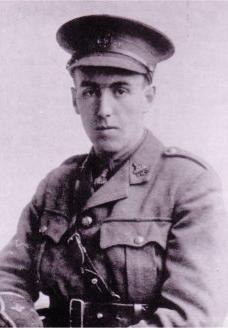Angus Buchanan (VC) facts for kids
Quick facts for kids
Angus Buchanan
VC MC
|
|
|---|---|
 |
|
| Born | 11 September 1894 Coleford, Gloucestershire |
| Died | 1 March 1944 (aged 49) Gloucester, Gloucestershire |
| Buried |
Coleford Cemetery
|
| Allegiance | |
| Service/ |
|
| Years of service | 1914 – 1917 |
| Rank | Captain |
| Unit | South Wales Borderers |
| Battles/wars | World War I |
| Awards | Military Cross Order of St. Vladimir 4th Class with Swords (Russia) |
| Other work | Solicitor |
Angus Buchanan (born August 11, 1894 – died March 1, 1944) was a brave English soldier. He received the Victoria Cross (VC) and the Military Cross (MC). The Victoria Cross is the highest award for bravery a British or Commonwealth soldier can get. It is given for amazing courage when facing the enemy.
Contents
Early Life and Military Service
Growing Up and School
Angus Buchanan was born in Coleford, Gloucestershire. His father was a doctor. He went to Monmouth School and was even the head boy there. In 1913, he started studying classics at Jesus College, Oxford. His teachers thought he was a hard worker. He was also good at sports, playing rugby and rowing for his college.
Joining the Army
When World War I began, Angus joined the army. He fought in important battles like the one at Gallipoli and in Mesopotamia. He showed great courage early on. In 1916, he received the Military Cross for his bravery. He was also mentioned four times in official reports for his actions.
Awarded the Victoria Cross
A Heroic Rescue
Angus Buchanan was 21 years old during the First World War. He was a temporary captain in the 4th Battalion of the South Wales Borderers. On April 5, 1916, his unit was trying to help British forces trapped in a place called Kut. During a battle at the Falauyah Lines, Angus showed incredible bravery. While under heavy enemy fire, he risked his life to rescue two wounded soldiers.
Receiving the Award
His amazing act of courage was officially announced on September 26, 1916. On November 8, 1917, King George V himself presented Angus with the Victoria Cross and the Military Cross. This special ceremony took place in Bristol. Before this, in July 1916, Angus had also received a Russian award called the Order of St. Vladimir 4th Class.
Life After the War
Facing Blindness
On February 13, 1917, Angus Buchanan was shot in the head by an enemy sniper. This injury caused him to become permanently blind. He later said that his survival was thanks to the excellent care he received from his helper, Private Mark Perry.
New Challenges and Contributions
After the war, Angus returned to Jesus College, Oxford. Even though he was blind, he studied law and even rowed for his college again in 1919. After finishing his studies in 1921, he worked as a solicitor (a type of lawyer) in Oxford. Later, he moved back to his hometown of Coleford.
In 1921, he helped unveil a war memorial at Monmouth School, his old school. People in Coleford raised money to honor his bravery. Angus asked them to use the money to buy a playing field for local children. He died on March 1, 1944, and was buried in Coleford Cemetery, right next to the recreation field named after him.
Remembering Angus Buchanan
Angus Buchanan is remembered in several ways. The playing field in Coleford is named in his honor. At Monmouth School, a boarding house for older students, Buchanan House, is named after him. His Victoria Cross medal was once displayed at a museum in Brecon. In 2013, it was bought by Michael Ashcroft and is now part of the Lord Ashcroft VC Collection at The Imperial War Museum.
See also
- Monuments to Courage (David Harvey, 1999)
- The Register of the Victoria Cross (This England, 1997)

